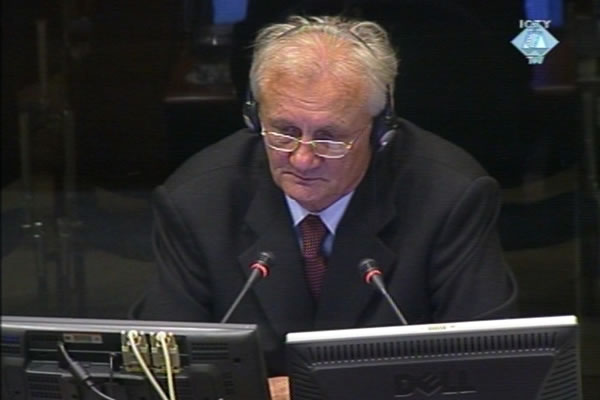Home
POINTS FOR ASSISTANCE OR EXPULSION?
Branko Krga, former chief of General Staff, claims that in 1999 the VJ had no interest in expelling Albanian civilians from Kosovo, as seen from the fact that it set up points where the Albanian people were to be ‘assisted’. Kosovo Albanians who testified in this case claimed that at those points they were directed towards Albania and Macedonia
 Branko Krga, defense witness for Dragoljub Ojdanic
Branko Krga, defense witness for Dragoljub Ojdanic Branko Krga, wartime chief of the Intelligence Administration in the VJ General Staff claims that before the air strikes the military leadership did all it could to push for a political solution of the Kosovo crisis. At the same time, it monitored NATO’s preparations for the attack. In 2002, Krga was appointed the chief of General Staff. Today he testified in the defense of his predecessor, General Dragoljub Ojdanic.
In an effort to show that the accused was willing to compromise, the witness said that in March 1999 the witness spoke with NATO supreme commander Wesley Clark on the phone four times. The first conversation was ‘calm’, with Clark inviting Ojdanic to attend the talks in Brussels and offering cooperation to the Yugoslav Army. On 22 and 24 March, the ‘calm’ tone gave way to threats that the Army would be destroyed, and the attack on the FRY followed. During the air strikes, the military leadership tried to find a way to achieve a compromise solution. The efforts culminated in the signing of the Kumanovo agreement on 9 June 1999. Krga was a member of the military delegation that initialed the agreement, with General Ojdanic’s approval.
Trying to contest the prosecution’s argument that the Serbian security forces are responsible for the expulsion of Albanian civilians from Kosovo, the witness said that intelligence from sources close to the Italian government indicated that as early as in February 1999 NATO already had a plan for taking care of 200,000 to 500,000 Albanian refugees in Albania and Macedonia. This means that the movements of the population were part of NATO’s broader plans. The Albanian civilians moved towards the border at the beginning of the war in order to put some distance between themselves and the VJ units. This isolated the troops, which thus became easy targets for NATO airplanes.
Most of the victims who were expelled from Kosovo who testified as prosecution witnesses claimed they had been expelled after the police had entered their villages. They were directed towards the border at police and military points. Countering their evidence, Krga said that the VJ had set up points to ‘help those people’ and to ‘show the world’ that the military had had no interest in expelling the civilians. Ojdanic’s defense tendered into evidence the wartime proclamation issued by the VJ General Staff, urging the Albanians not to leave their homes.
Finally, Krga claimed that his administration had had intelligence indicating the KLA extremist wing had been treating their compatriots cruelly in order to blame the murders, expulsions and torching of houses on the VJ.
The witness will be cross-examined by the prosecutor tomorrow.
Linked Reports
- Case : Sainovic et al.
- 2007-10-02 MILITARY JUDICIAL SYSTEM: WAS IT EFFICIENT?
- 2007-04-24 LILIC’S EVIDENCE POSTPONED UNTIL 1 MAY 2007
- 2007-04-17 KLA BOUGHT WEAPONS FROM VJ
- 2007-10-04 PROCLAMATION IN A WRONG LANGUAGE
- 2007-10-05 ON THE ORDERS OF A NON-EXISTENT COMMAND
- 2007-10-18 GENERAL STAFF: IS IT A COMMAND OR WORKING BODY?
